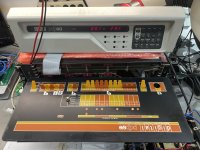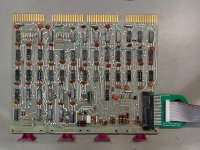anders_bzn
Experienced Member
This summer I finally got a PDP-8/E into my collection. I swapped some computers with a friend, I got this and he got some others... This machine must have been the cheapest PDP-8/E that you could buy. It really don’t know if the configuration makes sense, could one even av any use of a DECTape drive without OS/8 and 8(or 12)K of RAM.
It came with:
I have some cards in my collection that should go into this machine.
I would like to get my hands on
So far I have replaced one broken fan in the PSU and tested it (without load so far) I have also replaced all broken light bulbs on the front panel (this drained my stock completely) and tested it in my PDP-8a. It has issues with LA. The machine seams to be in good condition, only minor issues. One toggle switch for example, but not in the usual way.,,



It came with:
- Only one backplane
- 4K of memory
- A TU56H (and TD8E)
- PC04R (reader only)
- KL8E wired for 110 baud current loop
I have some cards in my collection that should go into this machine.
- The RK8E along with the RK05, this have I restored and used with my PDP-8A but this has been put aside for a while since I lack space.
- A extra KL8E, for serialdisk maybe.
- A RX8E, and a RK01 (I think I have one extra from my PDP-11’s)
- An extended memory control board M837
I would like to get my hands on
- 8K memory stack, one or two

- A second backplane. I have one on loan but I’m missing the power cable harness.
- The bootstrap module M847/MI8E in some version.
- For a start I can use two 4K mos memories that I also have lying around.
So far I have replaced one broken fan in the PSU and tested it (without load so far) I have also replaced all broken light bulbs on the front panel (this drained my stock completely) and tested it in my PDP-8a. It has issues with LA. The machine seams to be in good condition, only minor issues. One toggle switch for example, but not in the usual way.,,







